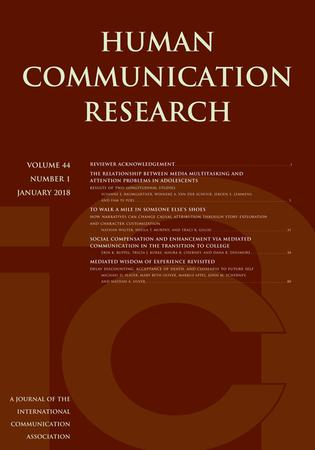人工智能时代的说服:基于人工智能的说服理论及其复杂性
IF 3.3
1区 文学
Q1 COMMUNICATION
引用次数: 12
摘要
人工智能对沟通和说服都有着深远的影响。我们考虑人工智能如何使说服理论和研究复杂化并促进重新思考。我们将基于人工智能的说服定义为一个象征性的过程,在这个过程中,交流的人工智能实体生成、增强或修改一条信息,旨在说服人们塑造、强化或改变他们的反应,并将其传递给人类接受者。我们回顾了有助于研究基于人工智能的说服的理论视角——计算机是社会行动者(CASA)范式、模态、代理、互动和导航(MAIN)模型以及说服的启发式系统模型——以解释人工智能的差异如何从两个方面使说服复杂化。首先,瘦人工智能很少(如果有的话)表现出机械(即人工智能)线索,社交线索可能是可用的,交流是有限和间接的。其次,厚厚的人工智能显示出充足的机械和社会线索,人工智能的存在是明显的,交流是直接和互动的。我们对每种情况提出了未来研究的途径。本文章由计算机程序翻译,如有差异,请以英文原文为准。
Persuasion in the Age of Artificial Intelligence (AI): Theories and Complications of AI-Based Persuasion
Artificial intelligence (AI) has profound implications for both communication and persuasion. We consider how AI complicates and promotes rethinking of persuasion theory and research. We define AI-based persuasion as a symbolic process in which a communicative-AI entity generates, augments, or modifies a message—designed to convince people to shape, reinforce, or change their responses—that is transmitted to human receivers. We review theoretical perspectives useful for studying AI-based persuasion—the Computers Are Social Actors (CASA) paradigm, the Modality, Agency, Interactivity, and Navigability (MAIN) model, and the heuristic-systematic model of persuasion—to explicate how differences in AI complicate persuasion in two ways. First, thin AI exhibits few (if any) machinic (i.e., AI) cues, social cues might be available, and communication is limited and indirect. Second, thick AI exhibits ample machinic and social cues, AI presence is obvious, and communication is direct and interactive. We suggest avenues for future research in each case.
求助全文
通过发布文献求助,成功后即可免费获取论文全文。
去求助
来源期刊

Human Communication Research
COMMUNICATION-
CiteScore
8.20
自引率
2.00%
发文量
28
期刊介绍:
Human Communication Research is one of the official journals of the prestigious International Communication Association and concentrates on presenting the best empirical work in the area of human communication. It is a top-ranked communication studies journal and one of the top ten journals in the field of human communication. Major topic areas for the journal include language and social interaction, nonverbal communication, interpersonal communication, organizational communication and new technologies, mass communication, health communication, intercultural communication, and developmental issues in communication.
 求助内容:
求助内容: 应助结果提醒方式:
应助结果提醒方式:


